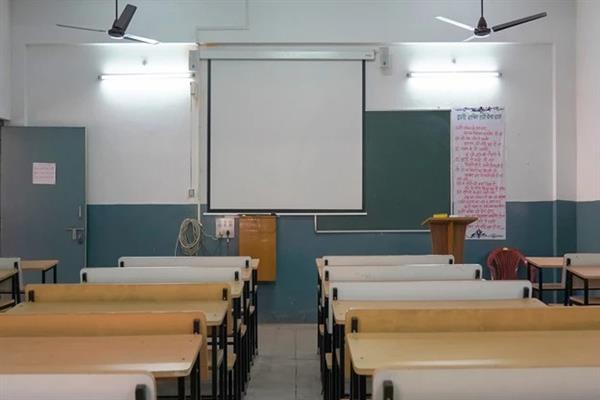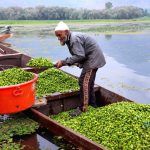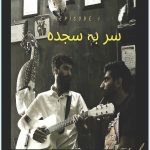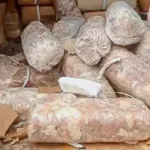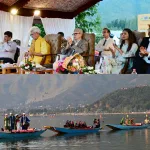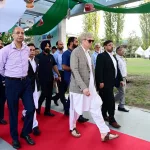In the shadow of the towering Himalayas, where the borders of cultures and languages intersect, a diverse situation has been unfolding in the classrooms of Jammu & Kashmir. Recent statistics paint an esoteric picture: The analysis of the enrolment for the academic year 2023-24 and 2022-23 as per the UDISE+ data of government schools has shown a decline in the enrolment of students by 61,451 in one year.The decline in enrollment has been observed while comparing the UDISE data for 2022-23 and 2023-24.Yet, amid these challenges, innovative educators are pioneering solutions that could transform the region’s educational landscape.
“When I first entered my classroom, I faced 30 young faces speaking seven different languages,” says a teacher at a government school in a remote border village of Tangdar “The textbooks in my hand might as well have been written in Greek for some of them.” Her experience epitomizes the complex linguistic and cultural complexity that characterizes education in most of the border and ruler classrooms in Jammu & Kashmir.
The Numbers Tell a Story
Several schools are showing a significant decline. 554 schools have been identified which are showing 61,451 decreases in enrolment,” reads an official communication addressed to all the CEOs. An education researcher explains, “These aren’t just numbers on a page. Each percentage point represents dreams deferred, potential untapped, and futures compromised. The scenario is particularly acute among many communities, where traditional lifestyles and modern education often struggle to find common ground.”
A Tale of Two Realities
In the border areas of Jammu & Kashmir, classrooms present a microcosm of India’s diversity challenge. Students from Gojri, Phari, Punjabi, Kashmiri, and even Bhojpuri-speaking backgrounds sit side by side. These students attempt to learn from teachers who often speak only one or two of these languages. The curriculum, designed outside of the school boundaries, frequently fails to resonate with the local context. “Imagine trying to understand fraction multiplication through examples of metro train schedules when you’ve never seen a metro in your life,” says Dr. Amarpreet, a research expert from SCERT-JK. “Now imagine trying to understand it in a language that isn’t your mother tongue.”
The Tribal Challenge
The situation is particularly complex for communities like the Gujjars and Bakarwals. Their seasonal migration patterns, essential for their traditional pastoral lifestyle, clash with the rigid structure of formal education. “We move with our herds to higher pastures in summer,” explains Nazir Ahmed, a Gujjar community member at TossaMaidan Bahakh in Budgam. “Our children’s education shouldn’t have to suffer because of our way of life, but currently, it does.”
Despite these challenges, there are glimmers of hope. The Gross Enrolment Ratio (GER) for tribal children at the primary level has shown a modest increase from 92.35 in 2013-14 to 94.30 in 2018-19. More significantly, secondary education enrollment among tribal children has risen by 7.82% between 2012-13 and 2018-19, with girls showing a remarkable 14.22% increase.
Innovation in the Face of Adversity
In response to these challenges, educators and administrators are implementing innovative solutions. The Project-Based Learning (PBL) initiative, recently introduced by SCERT-JK represents a paradigm shift in teaching methodology.”We’re moving away from the traditional ‘chalk and talk’ method,” explains Prof. (Dr.) Parikshat Singh Manhas, Director of State Council of Educational Research & Training. (SCERT-JK). “Our new approach emphasizes learning through doing, understanding through experience, and assessment through creation.”
The Multilingual Revolution
One of the most promising innovations is the introduction of multilingual teaching strategies. Teachers are being trained in basic conversational skills in multiple local languages, enabling them to build rapport with students and ensure foundational instruction in their mother tongues.Shabir Hussain Shabir, a multilingual expert at SCERT-KD says “When children start using even basic phrases in Urdu, Kashmiri and Gojri, we see an immediate change in the students’ engagement. Their eyes lit up, and suddenly, the classroom becomes a space where they feel they belong to.”
Technology as a Bridge
In some schools, technology is being leveraged to overcome linguistic barriers. Educational apps that can translate lessons into multiple languages are being piloted, though infrastructure challenges remain significant. “When we have electricity and internet connectivity, these tools are transformative,” notes Mr. Riyaz, an IT expert from SCERT. “The challenge is ensuring consistent access.”
Cultural Integration: The Missing Link
Perhaps the most significant innovation is the move toward cultural integration in education. Schools are increasingly incorporating local knowledge, traditions, and practices into their curriculum. Traditional crafts, local history, and indigenous knowledge systems are being woven into lesson plans.”We’re teaching mathematics through local market transactions, science through traditional farming practices, and language through local folklore,” explains Dr. Mudasir, a curriculum developer. “When education speaks the language of the community – both literally and metaphorically – learning becomes natural.”
The Gender Question
The higher dropout rates among girls remains a persistent concern. However, innovative programs like the Kasturba Gandhi Balika Vidyalayas (KGBVs) are showing promising results. These residential schools, specifically designed for girls from marginalized communities, have become beacons of hope.
“In the KGBV, we don’t just teach subjects; we nurture dreams,” says Ms. Shugufta, an expert of Inclusive pedagogy. “When girls see role models from their own communities succeeding, it changes their perception of what’s possible.”
Special Needs: The Next Frontier
The traditional pen-and-paper assessment system has long disadvantaged students with special needs. Now, schools are experimenting with alternative assessment methods, including oral examinations, portfolio-based evaluation, and project work generally known as school-based assessment which is expected to help the child grow holistically. “Every child has unique abilities,” asserts Masood Ali Mir, a special education expert at SCERT. “Our job is to create an environment where these abilities can flourish, regardless of the challenges they face.”
The Road Ahead
While innovations are showing promise, challenges remain formidable. Infrastructure deficits, particularly in remote areas, continue to hamper educational delivery. The seasonal migration of tribal communities requires flexible educational models that haven’t been fully developed yet.Shri Roshan Lal, Joint Director SCERT-Kashmir Division, outlines the vision: “We’re working toward an education system that’s as diverse as our people. It’s not just about keeping children in school; it’s about making school work for every child.”
Community Engagement: The Missing Piece
Successful educational transformation requires community buy-in. Schools are increasingly reaching out to parents and community leaders, making them partners in the educational process. “When parents understand what we’re trying to achieve, they become our strongest allies,” says Nazir Ahmad, a senior academic officer.
Looking to the Future
The challenges are complex, but the innovative responses emerging from classrooms and communities offer hope. The integration of traditional knowledge with culturally responsive pedagogy, the embrace of multilingual teaching, and the focus on 21st century skills are creating new possibilities.As Ab Rasheid Malla, a teacher, reflects, “Every morning when I enter my classroom now, I see not just students struggling with different languages, but young minds eager to learn in ways that make sense to them. That’s progress.”
The statistics may still be a cause of concern, but the ground-level innovations suggest a transformation is underway. As these initiatives mature and expand, they offer a model not just for Jammu & Kashmir, but for diverse, multilingual communities across India and beyond as envisaged in NEP-2020 followed by the curriculum frameworks for Foundation stage and School Education.The success of these educational innovations could have far-reaching implications for social cohesion and economic development in the region. As Prof. Manhas notes, “Education is not just about literacy; it’s about creating a foundation for lasting peace, and prosperity in our region.”
Conclusion
The education story in Jammu & Kashmir border areas presents an opportunity to reimagine education for diverse communities. The innovative approaches being developed here could serve as a blueprint for addressing similar challenges in other parts of the country.As the sun sets behind the mountains that have witnessed centuries of cultural exchange, the classrooms of Jammu & Kashmir are becoming laboratories for educational innovation. The challenge now is to scale these successful initiatives while maintaining their sensitivity to local needs and cultural contexts.”Every child who stays in school, every girl who completes her education, every tribal student who bridges traditional and modern knowledge – these are victories worth celebrating. But our work isn’t done until every child in every village has access to education that speaks their language, respects their culture, and opens doors to their future.”
In the end, the story of education in Jammu & Kashmir border areas is not just about statistics and challenges; it’s about hope, innovation, and the unwavering belief in the transformative power of education as National education Policy 2020 is the strong guideline for the road ahead. As these initiatives continue to evolve and expand, they offer a pathway toward an educational system that truly serves all of its children, regardless of their background, language, or circumstances.


